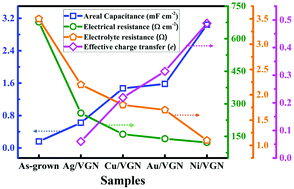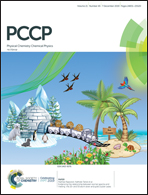Insights into the electrochemical capacitor performance of transition metal–vertical graphene nanosheet hybrid electrodes†
Abstract
Vertical graphene nanosheets (VGN) are envisioned as supercapacitor (SC) electrode materials due to their distinct geometry and remarkable properties. Of late, the hybrid structures of graphene-transition metal (TM) or oxides were found to exhibit enhanced charge storage capacity. Herein, we report the charge storage performance of VGN-transition metal nanoparticle (Au, Ag, Cu, and Ni) hybrid electrodes. Amongst them, Ni-decorated VGN exhibited the highest enhancement, up to 3.04 mF cm−2 (121.6 F g−1) compared to 0.16 mF cm−2 (6.4 F g−1) for as-grown VGN. Further, this was corroborated by the improved electrical as well as ionic conductivity of the metal-decorated VGN structures. Additionally, the presence of metal–oxygen–carbon bonding ensured a contribution of pseudocapacitance. Ab initio calculations elucidated the extent as well as the nature of charge (e−) transfer in TM nanoparticle–VGN hybrid structures. These findings are well corroborated with the charge storage performance. A combined effect from charge transfer and pseudocapacitance on the charge storage performance of TM nanoparticle–VGN hybrid electrodes is demonstrated. A symmetric coin-cell supercapacitor device using Ni/VGN electrodes was fabricated and the sustained performance tested over 10 000 charge–discharge cycles.



 Please wait while we load your content...
Please wait while we load your content...